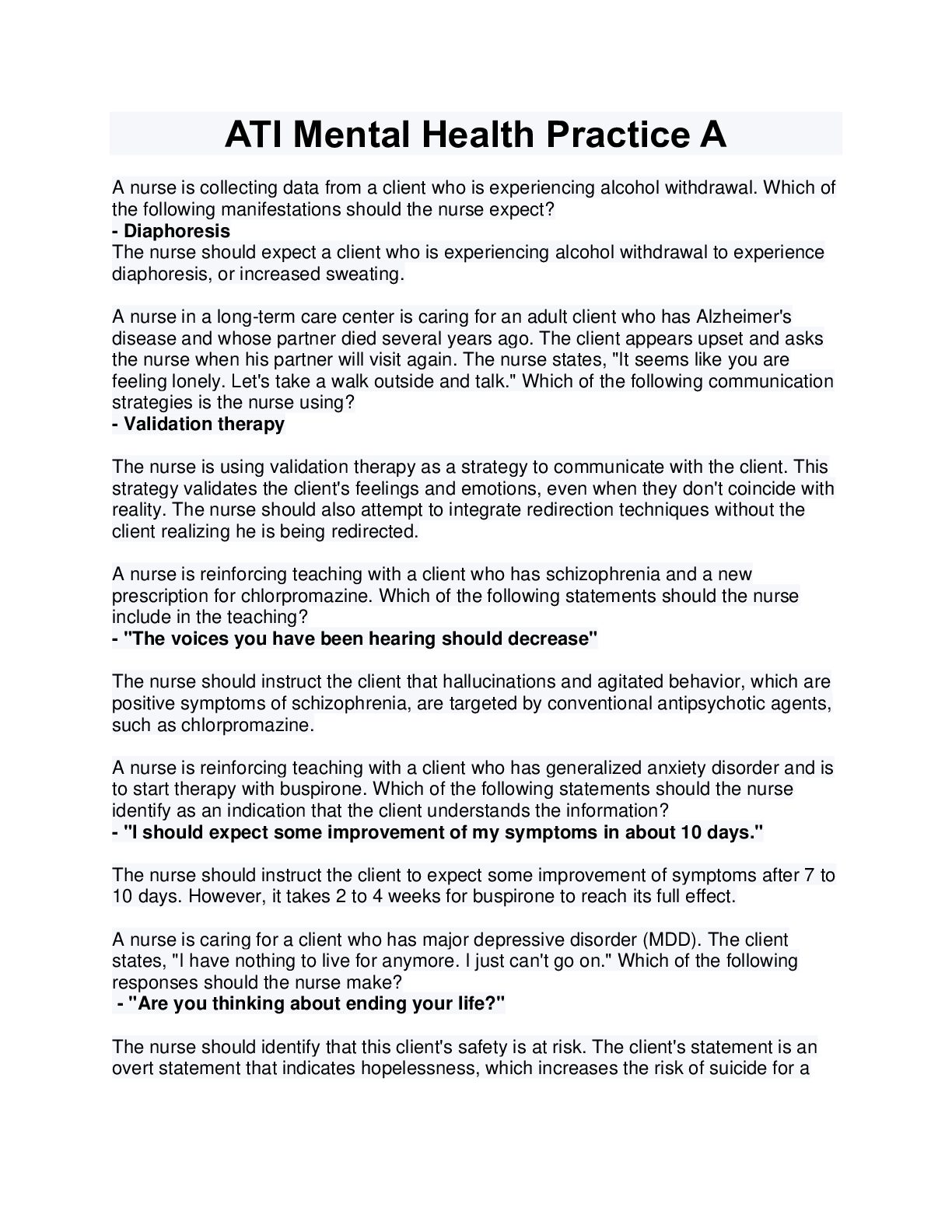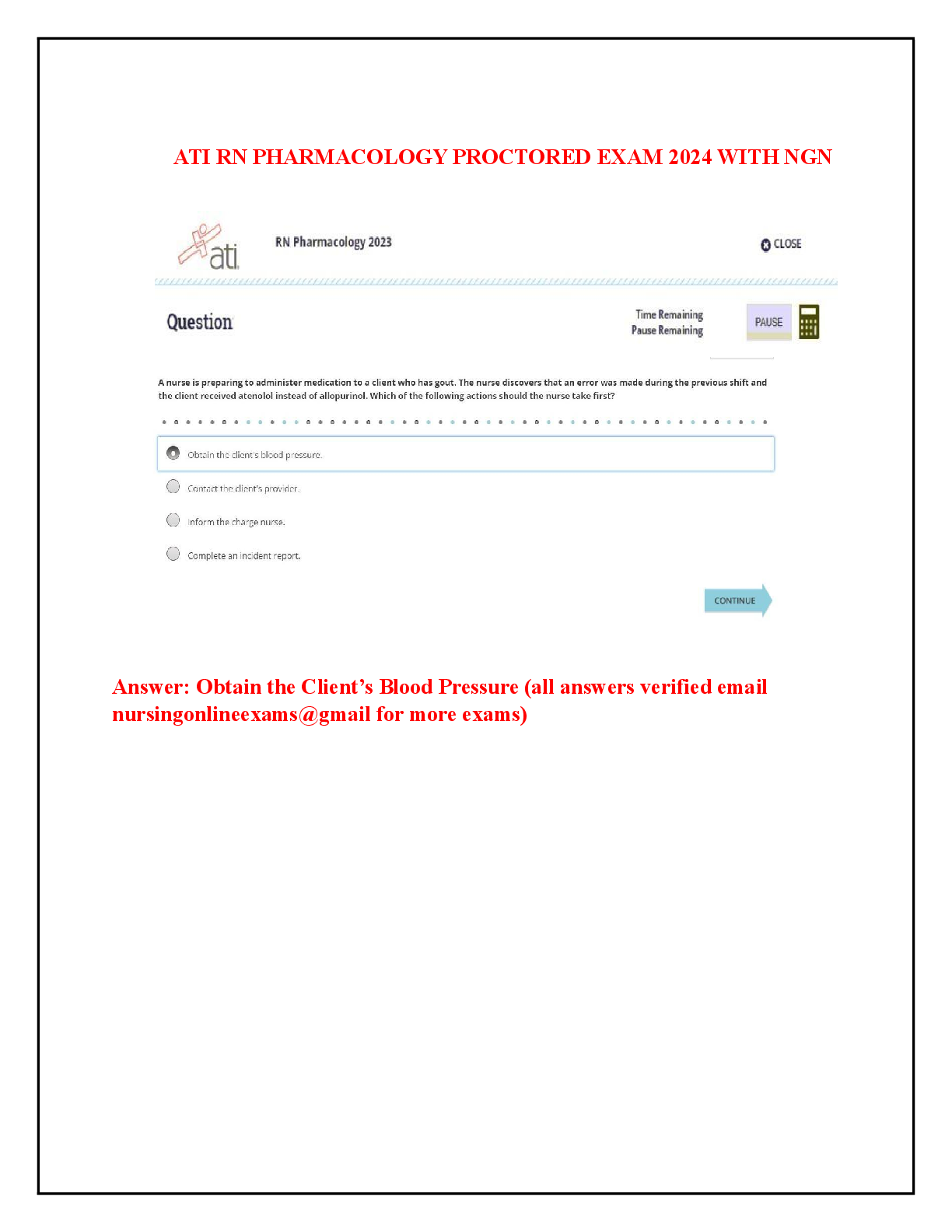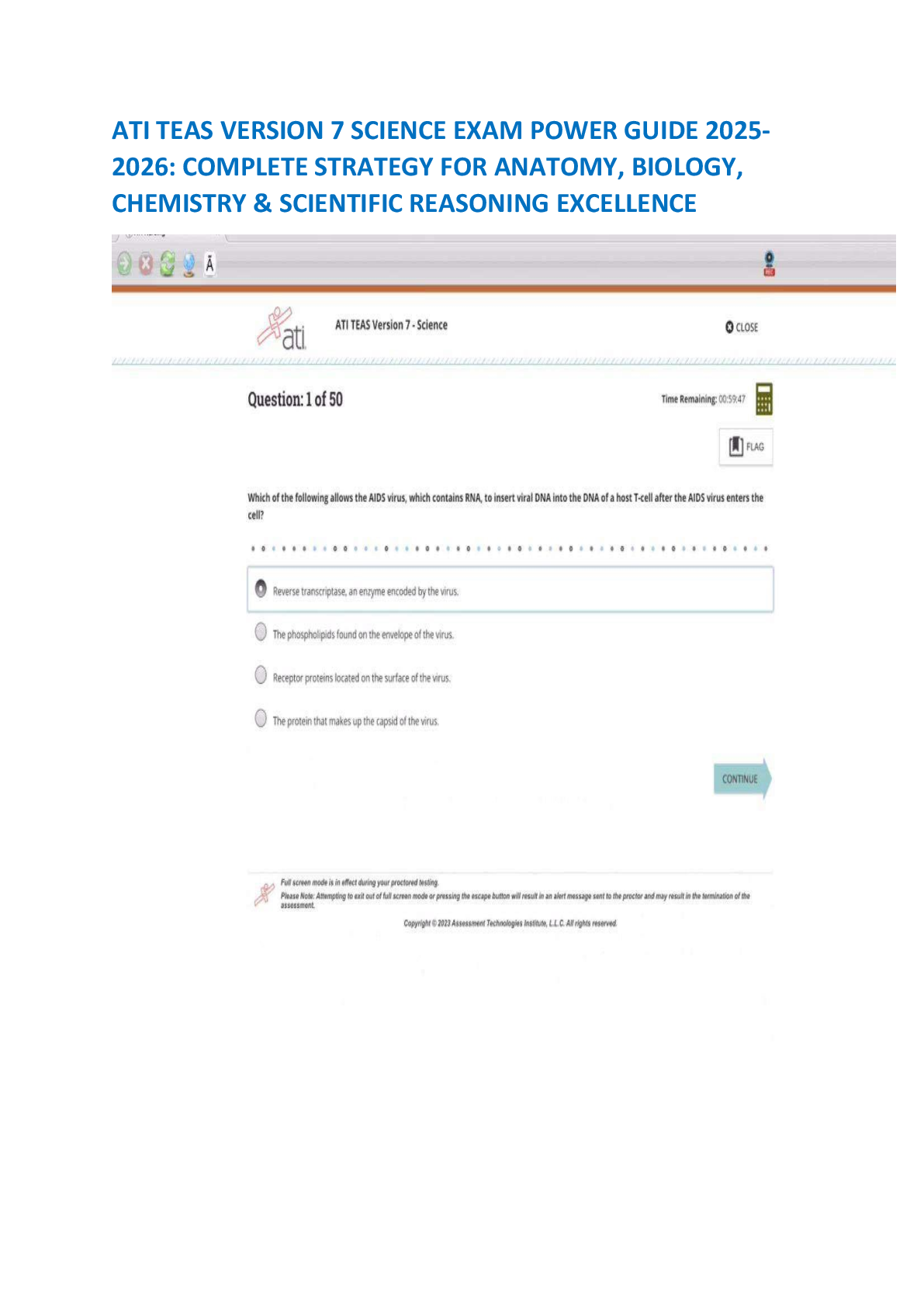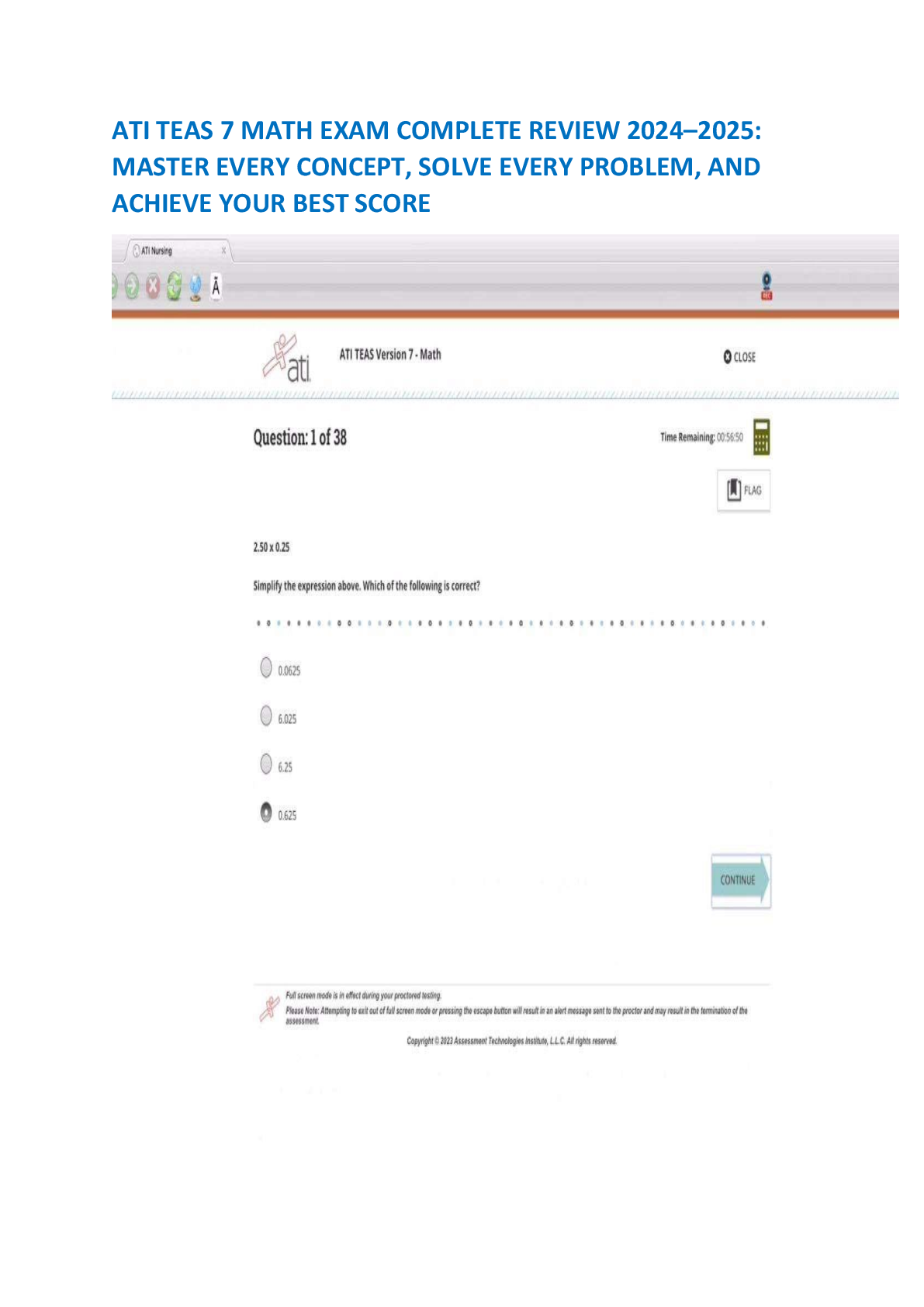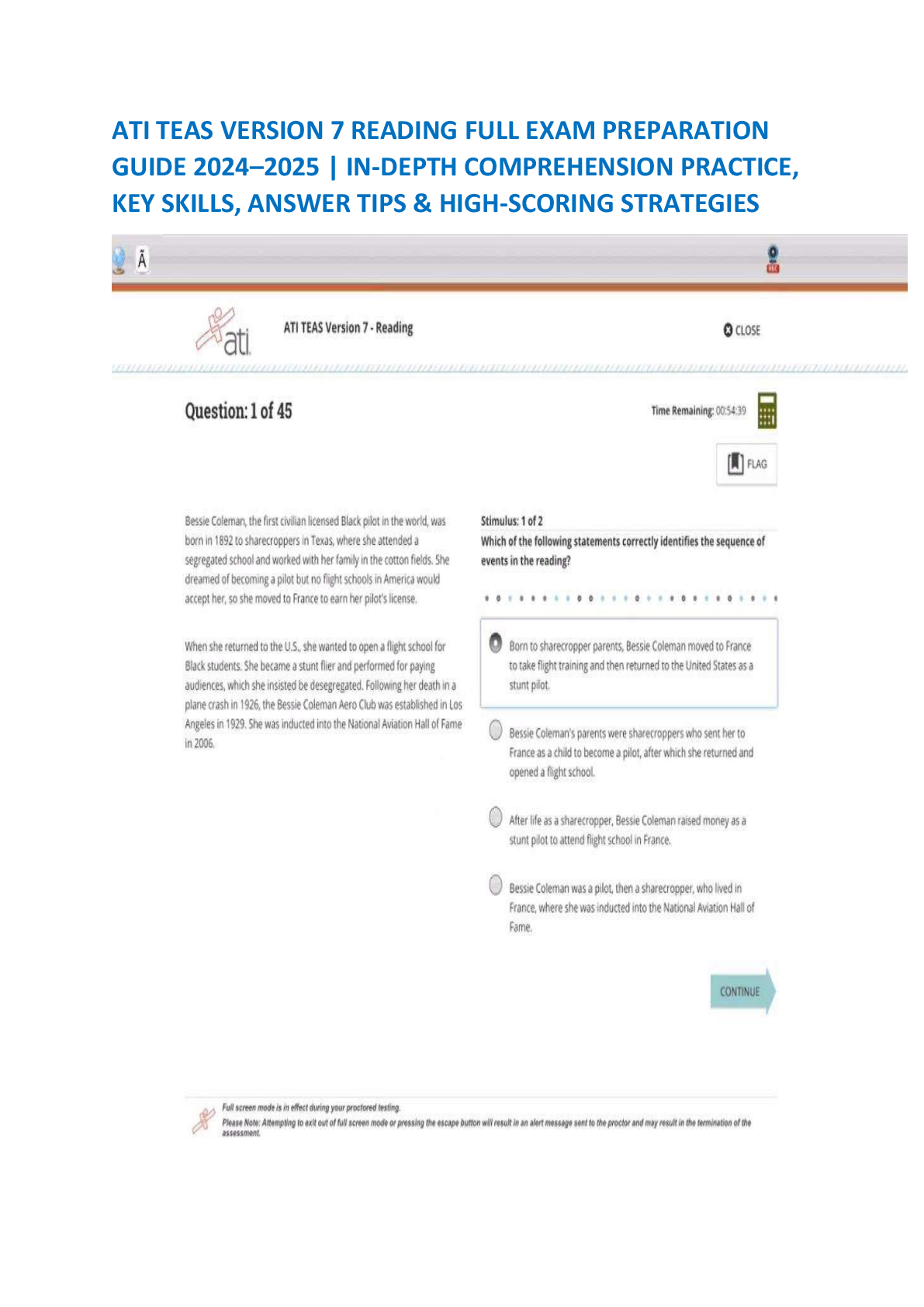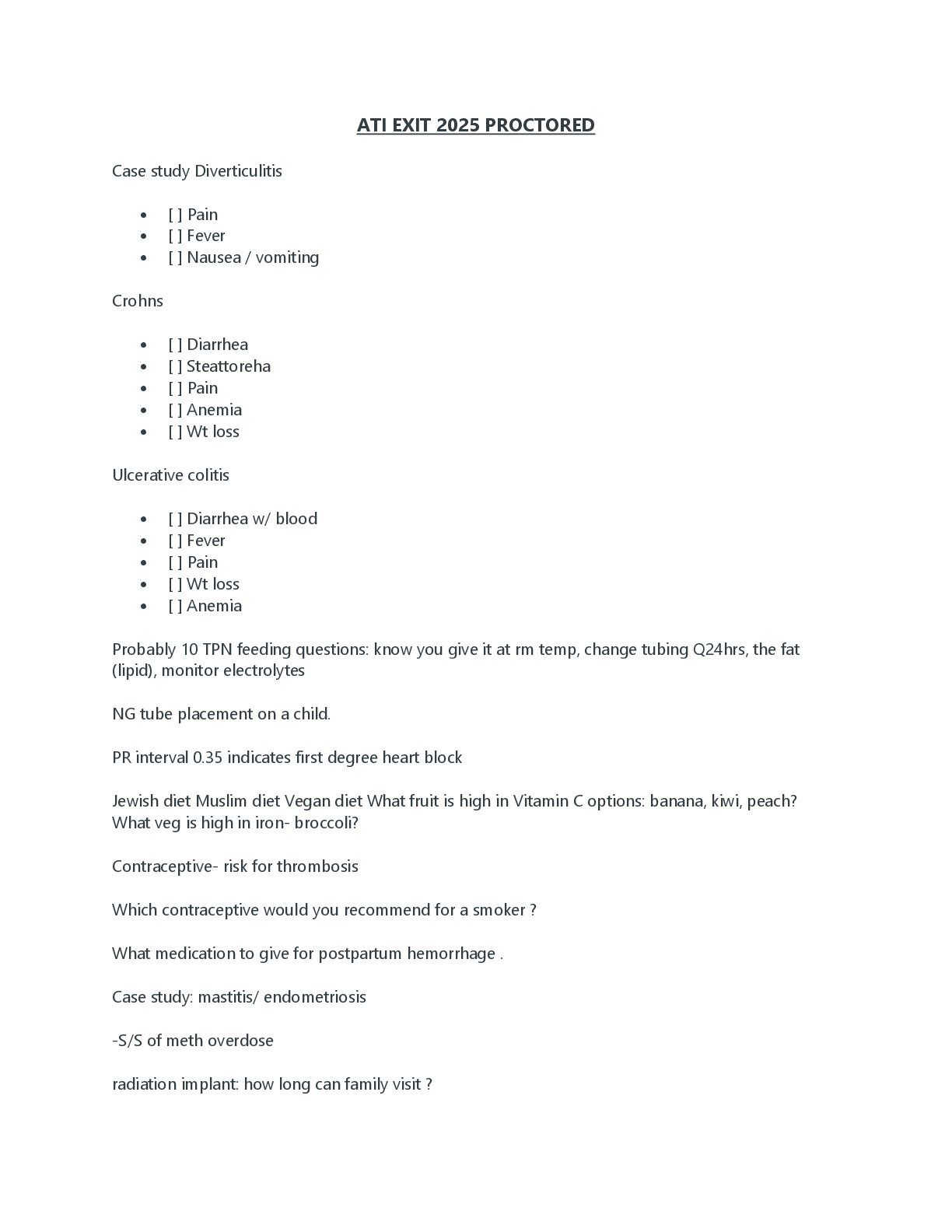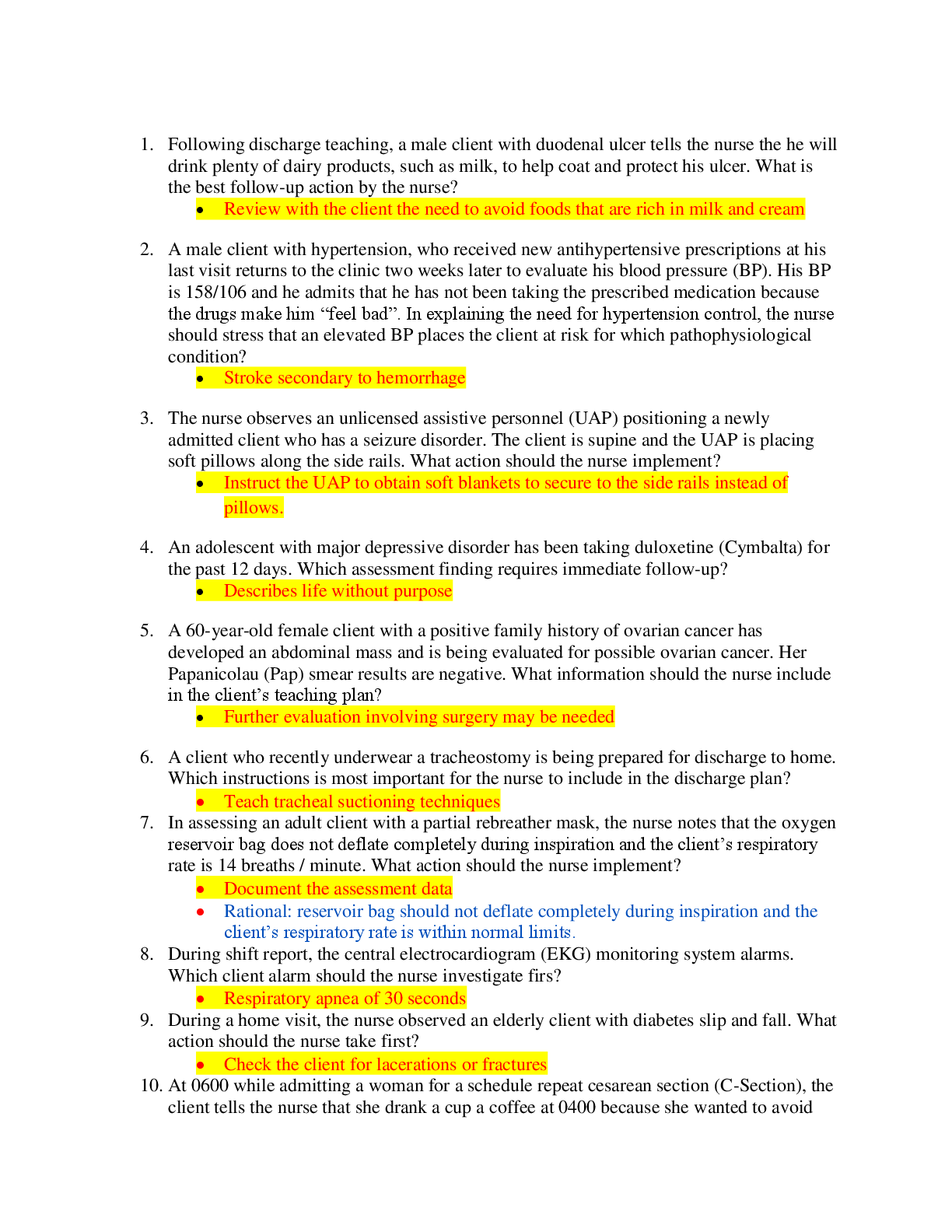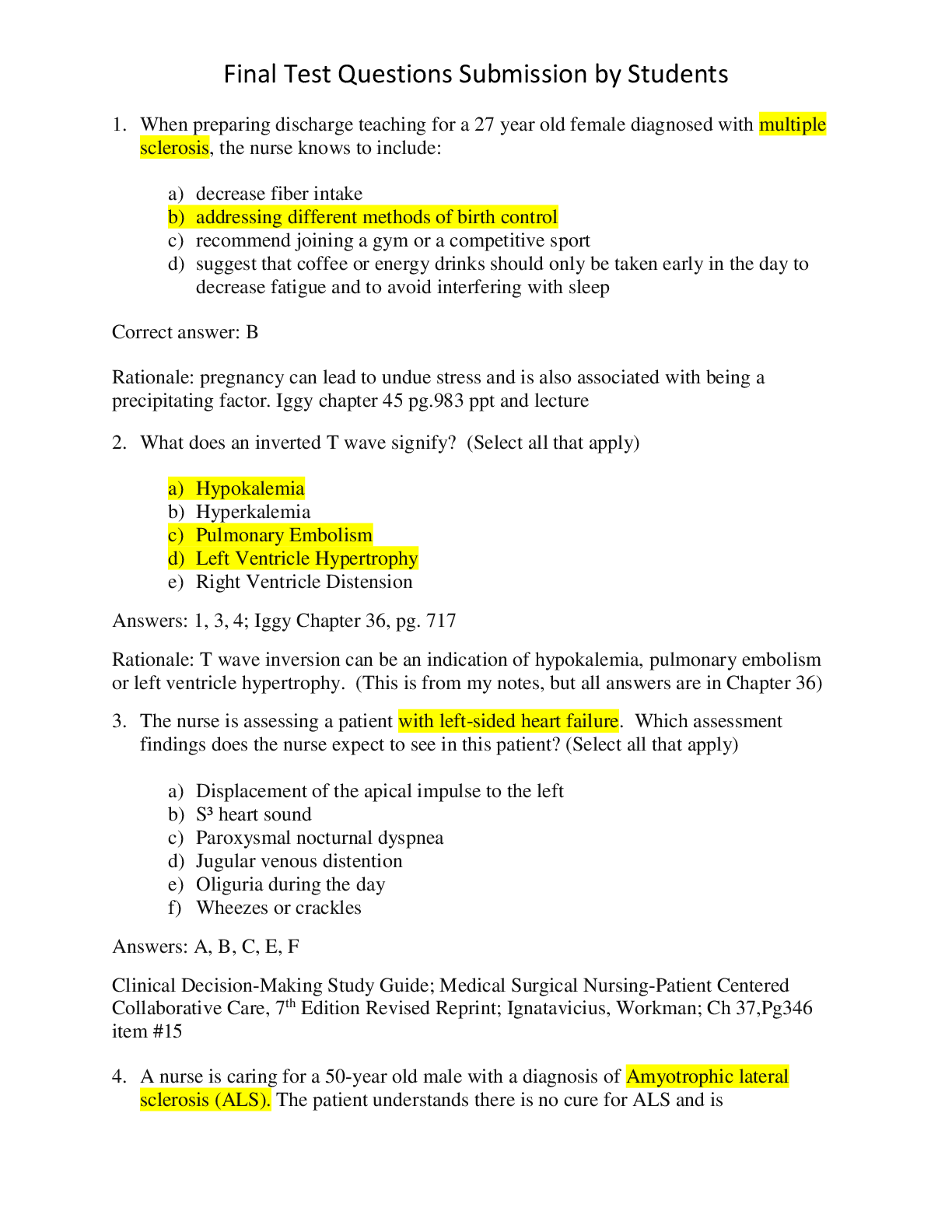Health Care > ATI > ATI RN Maternal Newborn Practice 2019 A/ Latest Updated /Q&A With Rationales (All)
ATI RN Maternal Newborn Practice 2019 A/ Latest Updated /Q&A With Rationales
Document Content and Description Below
A nurse is caring for a client who has uterine atony and is experiencing postpartum hemorrhage. Which of the following actions is the nurse's top priority? a) check client's capillary refill b) ma ... ssage the client's fundus c) insert an indwelling urinary catheter for the client d) Prepare the client for a blood transfusion. (ANS - b) massage the fundus Uterine atony and postpartum hemorrhage indicate that this client is at the greatest risk for hypovolemic shock. This can compromise the perfusion to the client's vital organs, which can lead to death. Therefore, the nurse's priority is to massage the client's fundus to minimize blood loss. All the other answers are actions the nurse should take, but the priority is massaging the fundus. A nurse is caring for a client who is to receive oxytocin to augment her labor. Which of the following findings contraindicates the initiation of the oxytocin infusion and should be reported to the provider? a) Late decelerations b) Moderate variability of the FHR c) Cessation of uterine dilation d) Prolonged active phase of labor (ANS - A) Late decelerations Late decelerations are indicative of uteroplacental insufficiency. Therefore, this is a contraindication for the administration of oxytocin and should be reported to the provider. Moderate variability of the FHR is an expected assessment finding associated with normal fetal acid-base balance. It is not a contraindication to the administration of oxytocin. Cessation of uterine dilation is an indication for the initiation of an oxytocin infusion to augment the client's labor progression. A prolonged active phase of labor is an indication for the initiation of an oxytocin infusion to augment the client's labor progression. A nurse is assessing a client who has severe preeclampsia. Which of the following manifestations should the nurse expect? a) 2+ deep tendon reflexes b) Proteinuria of 200 mg in a 24-hr specimen c) Polyuria d) Blurred vision (ANS - d) Blurred vision The nurse should identify that a client who has severe preeclampsia can have arteriolar vasospasms and decreased blood flow to the retina which can lead to visual disturbances, such as blurred vision, double vision, or dark spots in the visual field. Patient would have 3+ or 4+ DTRs, proteinuria >500 mg, decreased urine output of 20 mL/hr A nurse is assessing a client who is 1 day postpartum and has a vaginal hematoma. Which of the following manifestations should the nurse expect? a) Lochia serosa vaginal drainage b) Vaginal pressure c) Intermittent vaginal pain d) Yellow exudate vaginal drainage (ANS - b) Vaginal pressure The nurse should expect a client who has a vaginal hematoma to report pressure in the vagina due to the blood that leaked into the tissues. Patient will report persistent, not intermittent pain and lochia rubra. A nurse is caring for a client who is at 36 weeks of gestation and has as positive contraction stress test. The nurse should plan to prepare the client for which of the following diagnostic tests? a) Biophysical profile b) Amniocentesis c) Cordocentesis d) Kleihauer-Betke test (ANS - a) Biophysical profile A positive contraction stress test indicates that further evaluation of the fetus is necessary. A biophysical profile will provide further evaluation with a real-time ultrasound. An amniocentesis is used to determine lung maturity, detect congenital anomalies, and diagnose fetal hemolytic disease. A cordocentesis is used to identify fetal blood type and RBC when there is a risk of isoimmune hemolytic anemia. The Kleihauer-Betke test is used to determine the amount of fetal blood in the maternal circulation when there is a risk of Rh-isoimmunization. A nurse is providing teaching for a client who has a new prescription for combined oral contraceptives. Which of the following findings should the nurse include as an adverse effect of this medication? a) Depression b) Polyuria c) Hypotension d) Urticaria (ANS - a) Depression The nurse should instruct the client that depression is a common adverse effect of combined oral contraceptives. Other common adverse effects of the medication include amenorrhea, weight gain, headache, nausea, breakthrough bleeding, and breast tenderness. Fluid retention can occur due to an excess of estrogen. Polyuria is not a common adverse effect of the medication. Hypertension, rather than hypotension, is a common adverse effect of combined oral contraceptives. Urticaria is not a common adverse effect of combined oral contraceptives. A nurse is caring for a postpartum client who is receiving heparin via a continuous IV infusion for thrombophlebitis in her left calf. Which of the following actions should the nurse take? a) Administer aspirin for pain. b) Maintain the client on bed rest. c) Massage the affected leg every 12 hr. d) Apply cold compresses to the affected calf. (ANS - b) Maintain the client on bed rest. The client should remain on bed rest to decrease the risk of dislodging the clot, which could cause a pulmonary embolism. Elevation of the affected leg is recommended. A client receiving anticoagulant therapy, such as heparin, should not receive aspirin because it can lead to prolonged clotting times and increased risk of bleeding. The nurse should avoid massaging the affected leg to decrease the risk of dislodging the clot, which could cause a pulmonary embolism. The nurse should apply warm compresses to the affected area to promote circulation and decrease edema. A nurse is providing teaching to a client who is at 40 weeks of gestation and has a new prescription for misoprostol. Which of the following instructions should the nurse include in the teaching? a) "I can administer oxytocin 4 hours after the insertion of the medication." b) "You will need a full bladder prior to the insertion of the medication." c) "Remain in a side-lying position for 15 minutes after the medication is inserted." d) "An antacid will be given 20 minutes prior to the insertion of the medication." (ANS - a) "I can administer oxytocin 4 hours after the insertion of the medication." The nurse can administer oxytocin no sooner than 4 hr after the last dose of misoprostol. Oxytocin can be administered following misoprostol for clients who have cervical ripening and have not begun labor. The nurse should instruct the client to void prior to the administration of the medication. The nurse should instruct the client to remain in a side-lying position for 30 to 40 min after the insertion. The nurse should avoid administering aluminum hydroxide and magnesium-containing antacids with misoprostol. [Show More]
Last updated: 3 years ago
Preview 1 out of 37 pages
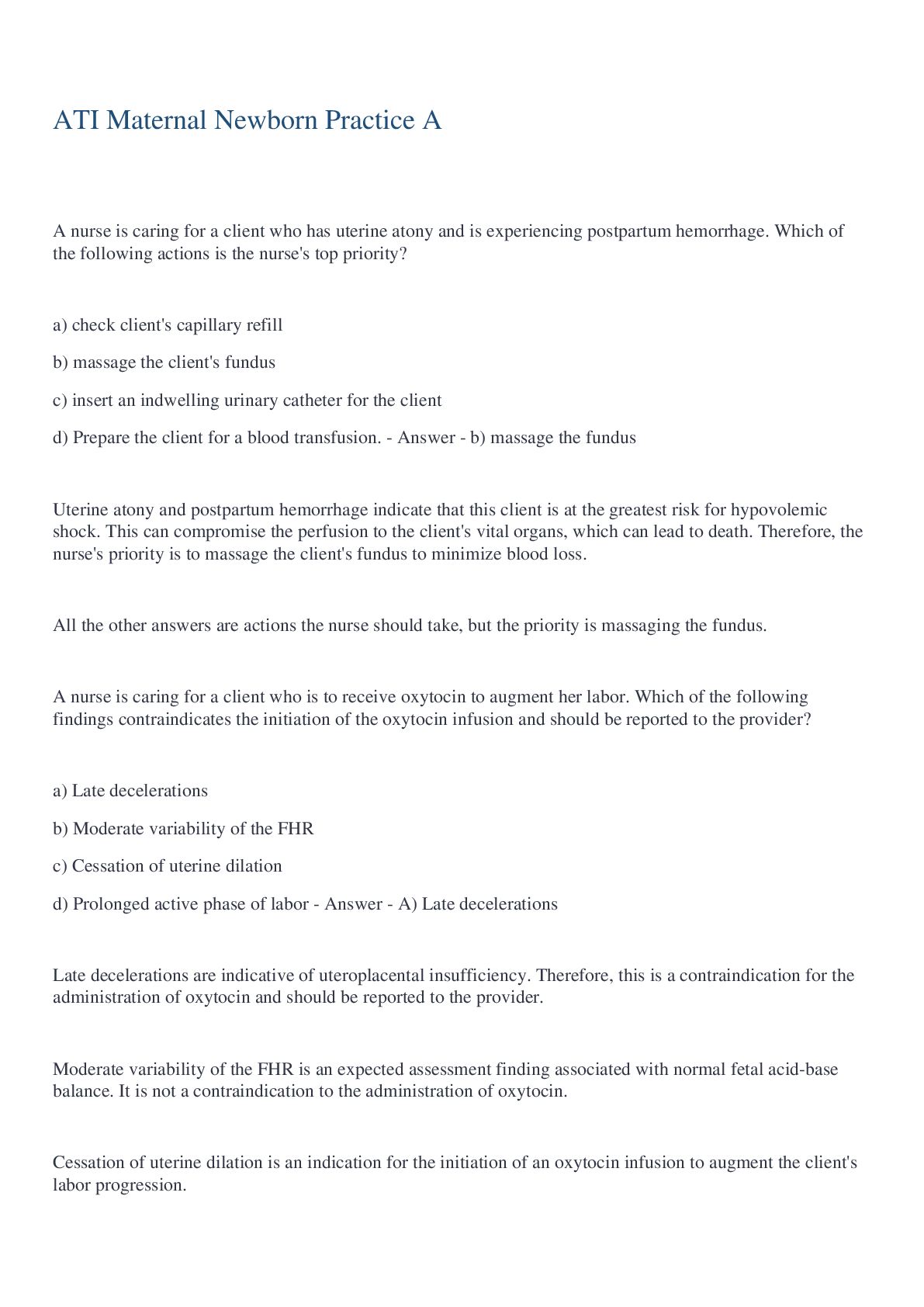
Buy this document to get the full access instantly
Instant Download Access after purchase
Buy NowInstant download
We Accept:

Also available in bundle (1)
Click Below to Access Bundle(s)

ATI Maternal Newborn Proctored Exam:ATI Maternal Newborn Proctored Exams: ATI PN Maternal Newborn Proctored Exam study guide: Updated Package Deal: Questions & Answers; A PLUS Score Solutions
ATI Maternal Newborn Proctored Exam:ATI Maternal Newborn Proctored Exams: ATI PN Maternal Newborn Proctored Exam study guide: Updated Package Deal: Questions & Answers; A PLUS Score Solutions
By Ace-It 2 years ago
$27
47
Reviews( 0 )
$10.00
Can't find what you want? Try our AI powered Search
Document information
Connected school, study & course
About the document
Uploaded On
Jun 02, 2022
Number of pages
37
Written in
All
Additional information
This document has been written for:
Uploaded
Jun 02, 2022
Downloads
0
Views
115











